Around Sartène
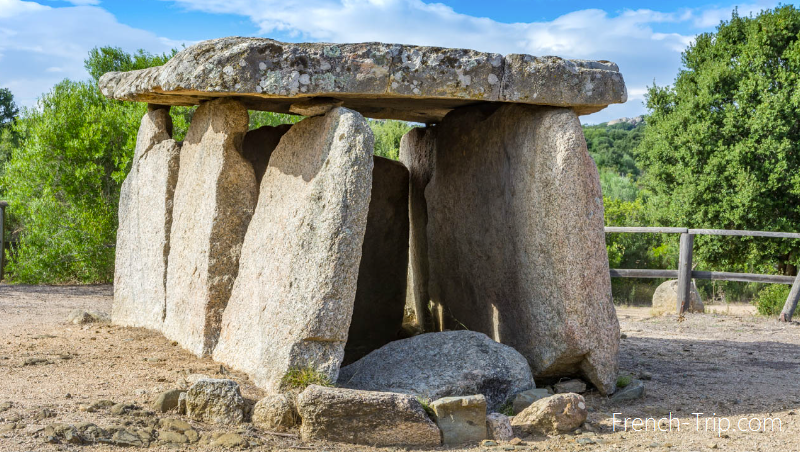
Sartène is not only remarkable in itself but also serves as an excellent base for exploring the surrounding areas. Around Sartène you will find ancient monuments dating back to the megalithic era.
General Tips
- Transport: While public transport options are limited, renting a car is highly recommended to explore these nearby attractions comfortably.
- Local Experience: Visiting these small villages and natural sites provides a deeper understanding of Corsican culture and the island’s natural beauty.
Around Sartène
1. Foce
- Distance: Approximately 2 km from Sartène.
- A small village nearby, ideal for a short visit to experience local Corsican village life.
2. Granace
- Distance: Approximately 2 km from Sartène.
- Another close village that offers a glimpse into traditional Corsican rural life.
3. Belvédère-Campomoro
- Distance: Approximately 11 km from Sartène.
- Known for its beautiful beach and the Genoese tower, which offers stunning views of the coastline. Although slightly beyond the 10 km mark, it is a popular nearby destination.
4. Altagène
- Distance: Approximately 12 km from Sartène.
- A small, picturesque village known for its scenic beauty and traditional Corsican architecture. Like Belvédère-Campomoro, it is slightly beyond the 10 km range but worth mentioning.
5. Roccapina Rock
- Distance: Approximately 3.8 km from Sartène.
- A famous rock formation that resembles a lion. The area offers beautiful hiking trails and panoramic views of the surrounding landscape.
6. Cala di Conca and Tower of Senetosa
- Distance: Approximately 27.3 km from Sartène.
- A bit further out but notable for its challenging hiking trails and stunning coastal views
Hiking and Outdoor Activities
Around the Roccapina Rock: A popular hiking route that is 3.8 km long and takes about 1.5 hours to complete. It offers beautiful views and a chance to explore the natural beauty of the area.
Scenic route from Sartene
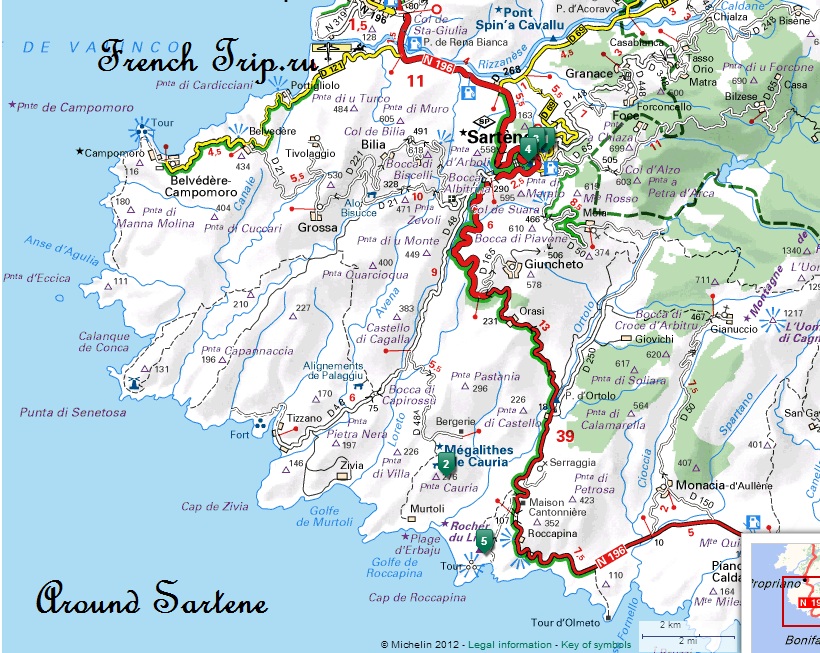
1 — Couvent Saint Côme et Damien
This Franciscan monastery, restored by a community of Belgian monks, faces the town of Sartène with its façade. It is here that sinners spend the night before the Catenacciu procession.
- Address: Cours Saint Damien, 20100 Sartène, France
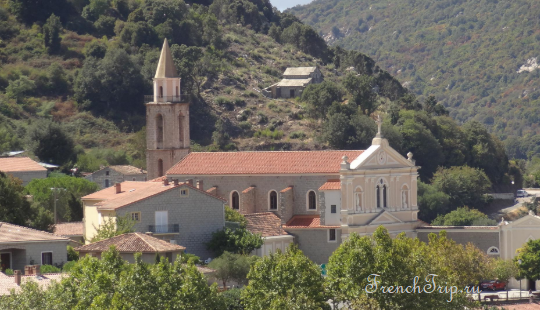
2 — Plateau de Cauria
Archaeological excavations on this plateau have uncovered more than 170 monolithic structures arranged chaotically. The standing stones of Stantari, lost in remote locations among vineyards and pastures, include a total of 11 menhirs. Among them are the most famous menhirs in Corsica, depicting armed figures with their long swords and attire.
At the foot of Punta Cauria, you will find a group of 40 menhirs, the standing stones of Renaju. And finally, the gate of the Fontanaccia Tomb, the most famous Corsican tomb, consists of 6 vertical pillars supporting a granite entablature.
- Route to Renaju — 16 km, 27 minutes. Route to Fontanaccia — 16 km, 26 minutes.
Megaliths of Cauria
In Cauria, located in the middle of solitude, you will find numerous menhirs and also the most beautiful dolmens in Corsica in a very small area. All three sites are easily accessible on foot. However, in the spring the meadows are sometimes very swampy. High walking boots are recommended at this time of year or after rainfall. To the west you will see the Cagna Mountains with the famous spherical rock Uomo di Cagna. The site is freely accessible.
Follow the wide footpath for just under 1 km to reach the Dolmen of Stantari.
Dolmen of Stantari
Here, now fenced, are 11 menhirs in two parallel rows. 5 of them are carved into menhir statues, some are even armed with daggers and swords. The faces are still very recognizable. Arms and hands are also indicated. There are more menhirs on the site. The latter were only discovered during excavations in 2004.
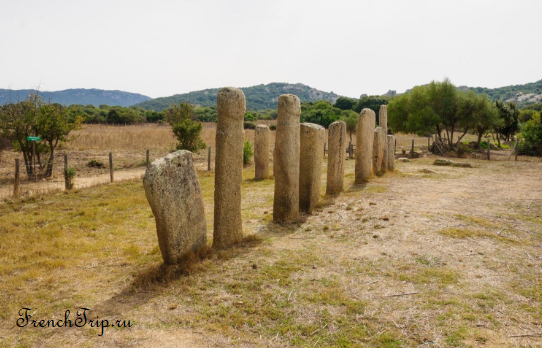
From the Stantari exit, follow the Plateau de Cauria southwards for over 400 m until the Renaju exit.
Dolmen of Renaju / Rinaghju / Renaghju / Rinaggiu
Nearly 50 menhirs stand and lie here in a criss-cross pattern in a kermes oak grove. They are much smaller than Stantari’s. They once stood in different rows, from north to south. During excavations in the 1960s, Roger Grosjean also discovered a stone cist grave here. Today only rough plates can be seen.
From the Dolmen de Renaju, head northwest to the Dolmen de Fontanaccia. Along the way you will pass a beautiful cork oak and cross a small forest. After 400 m you reach the dolmen.
Dolmen of Fontanaccia
This is the most beautiful dolmen in Corsica. It is 1.8 m high, 2.6 m long and 1.6 m wide. The 3.4 m long, 2.9 m wide and almost three tons heavy top plate rests on 6 plates. The dolmen is open to the west. It is said that there were once numerous dolmens and stone coffin graves in the immediate area. On the winter solstice, the sun shines directly on the back wall. The dolmen is also called Stazzone di u Diavole (Devil’s Forge). It has been fenced for several years.
5 — Roccapina
After the pass, follow the 3-km road that will lead you to Cala di Roccapina — a beautiful sandy beach very popular in the summer. The area stretching from Cap de Roccapina to the southern cape, including Cala di Roccapina, is a reserve inhabited by many waterfowl. On the cape, near the Genoese tower, the Lion of Roccapina stands out on the horizon. This monumental natural sculpture, resembling a lying lion, was formed by atmospheric erosion of the granite rock.
- 22 km from Sartène, 25 minutes by car.
Megaliths around Sartène:
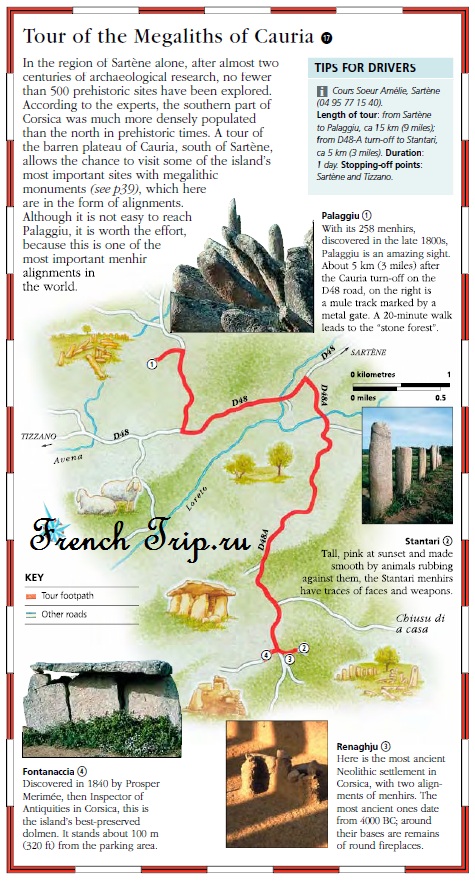
→ Get back to Corsica travel guide
Archives
Calendar
| M | T | W | T | F | S | S |
|---|---|---|---|---|---|---|
| 1 | 2 | 3 | 4 | 5 | 6 | 7 |
| 8 | 9 | 10 | 11 | 12 | 13 | 14 |
| 15 | 16 | 17 | 18 | 19 | 20 | 21 |
| 22 | 23 | 24 | 25 | 26 | 27 | 28 |
| 29 | 30 | 31 | ||||